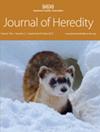A chromosome-level genome assembly for the dugong (Dugong dugon)
IF 3
2区 生物学
Q2 EVOLUTIONARY BIOLOGY
引用次数: 0
Abstract
The dugong (Dugong dugon) is a marine mammal widely distributed throughout the Indo-Pacific and the Red Sea, with a Vulnerable conservation status, and little is known about many of the more peripheral populations, some of which are thought to be close to extinction. We present a de novo high-quality genome assembly for the dugong from an individual belonging to the well-monitored Moreton Bay population in Queensland, Australia. Our assembly uses long-read PacBio HiFi sequencing and Omni-C data following the Vertebrate Genome Project pipeline to reach chromosome-level contiguity (24 chromosome-level scaffolds; 3.16 Gbp) and high completeness (97.9% complete BUSCOs). We observed relatively high genome-wide heterozygosity, which likely reflects historical population abundance before the last interglacial period, approximately 125,000 years ago. Demographic inference suggests that dugong populations began declining as sea levels fell after the last interglacial period, likely a result of population fragmentation and habitat loss due to the exposure of seagrass meadows. We find no evidence for ongoing recent inbreeding in this individual. However, runs of homozygosity indicate some past inbreeding. Our draft genome assembly will enable rangewide assessments of genetic diversity and adaptation, facilitate effective management of dugong populations, and allow comparative genomics analyses including with other sirenians, the oldest marine mammal lineage.儒艮染色体级基因组组装
儒艮(Dugong dugon)是一种海洋哺乳动物,广泛分布于印度洋-太平洋和红海地区,其保护状况极易受到威胁,人们对其许多边缘种群知之甚少,其中一些种群被认为濒临灭绝。我们从澳大利亚昆士兰莫尔顿湾监测良好的儒艮种群中提取了一个个体,并对其进行了全新的高质量基因组组装。我们的组装使用了长线程 PacBio HiFi 测序和 Omni-C 数据,遵循脊椎动物基因组计划管道,达到了染色体级的连续性(24 个染色体级支架;3.16 Gbp)和高完整性(97.9% 的完整 BUSCOs)。我们观察到相对较高的全基因组杂合度,这可能反映了大约 125,000 年前最后一次冰期之前的历史种群丰度。人口推断表明,儒艮种群数量在上一次冰期之后随着海平面的下降而开始减少,这可能是由于海草草甸的暴露造成的种群破碎和栖息地丧失的结果。我们没有发现该个体近亲繁殖的证据。不过,同源性的变化表明过去曾有过近亲繁殖。我们的基因组组装草案将有助于对整个范围内的遗传多样性和适应性进行评估,促进对儒艮种群的有效管理,并可进行基因组学比较分析,包括与其他海牛类(最古老的海洋哺乳动物品系)的比较分析。
本文章由计算机程序翻译,如有差异,请以英文原文为准。
求助全文
约1分钟内获得全文
求助全文
来源期刊

Journal of Heredity
生物-遗传学
CiteScore
5.20
自引率
6.50%
发文量
63
审稿时长
6-12 weeks
期刊介绍:
Over the last 100 years, the Journal of Heredity has established and maintained a tradition of scholarly excellence in the publication of genetics research. Virtually every major figure in the field has contributed to the journal.
Established in 1903, Journal of Heredity covers organismal genetics across a wide range of disciplines and taxa. Articles include such rapidly advancing fields as conservation genetics of endangered species, population structure and phylogeography, molecular evolution and speciation, molecular genetics of disease resistance in plants and animals, genetic biodiversity and relevant computer programs.
 求助内容:
求助内容: 应助结果提醒方式:
应助结果提醒方式:


